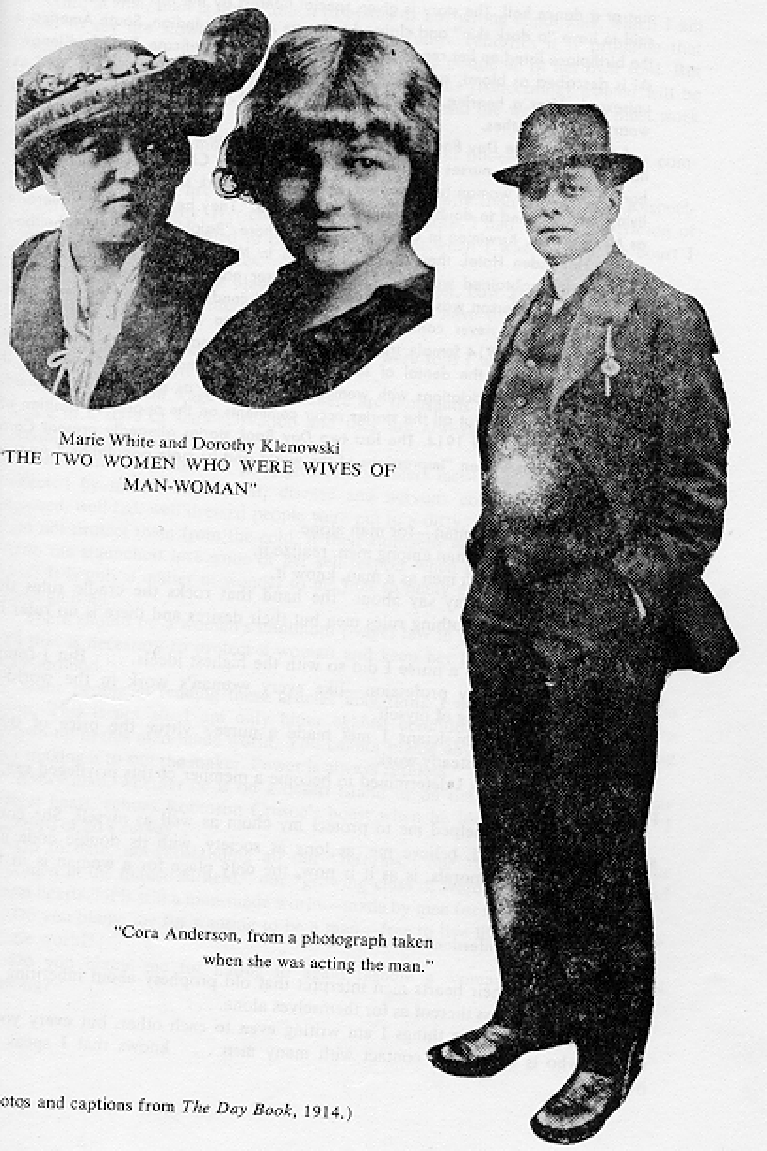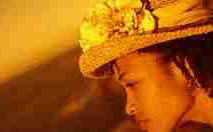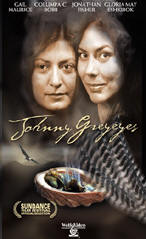
























  |
 World
View -- Sex and Spirit: Native American Lesbian Identity World
View -- Sex and Spirit: Native American Lesbian Identity
Native American and First
Nations lesbians have to deal with unique issues as a result of
their history, cultural status, and perceptions as Natives. They
come out of a history of genocide; their people have been
persecuted, killed, kidnapped, and assimilated for hundreds of
years and still face lingering aspects of genocide. They face
homophobia and sexism from their own people; racism from
lesbians; and racism, homophobia, and sexism from the dominant
society, not to mention the classism many Native Americans have
to deal with.
It is important to remember
that Native lesbians today are not the same as the Natives that
lived before the arrival of the white man. Interaction with
whites and the cultural genocide perpetrated on Natives has
changed Native Americans’ perception of gender and sexuality.
Though it is interesting to speculate about how two-spirits were
treated in traditional Native American cultures, a focus on such
speculation can hide the lives of Native American lesbians
today. Unfortunately, despite the encouraging things written
about the acceptance and honor of the "berdache" of the past,
Native lesbians today face homophobia in their own communities.
This is not a traditional Native American value, but a result of
the forcing of European culture and religion on Natives. The
attempts of whites to destroy any tolerance and respect for
female two-spirits is well reported. Writings exist from
missionaries about how Native women were told not to have sexual
relations with other women (Katz 298). Also, one can find how
Native stories about lesbians change from positive to very
negative, depending on where and when the story came from. Allen
and Cavin cite creator stories in which women have the most
important roles. Cavin argues that these are lesbian stories, or
at the very least non-heterosexual stories (45). According to
Cavin’s sources, lesbians were described in origin myths
positively as being in control of the wealth and were in charge
of the household and property. They were considered an asset to
her family and community. Later, after Native Americans where
pushed onto reservations, stories are found where relations
between lesbians end in tragedy. Katz has a few stories in which
lesbians give birth to babies with no bones (320) or that are
shaped like turtles (317-18). In one, a man kills his wife after
she seduces his sister and runs off with her. Katz and a man he
cites, McMurtrie (322), believe that the negative twist in these
stories are due to European influence, especially since both
were recorded after 1900. Katz also has several stories about
female "berdaches" in which the women (who dress like men and
marry women) are ridiculed. These women lived after the
influence of whites had plenty of time to seep into Native
American culture. Unfortunately, I can find no records of female
two-spirits that exist from before the whites came or when they
still had little influence on Native Americans.
Today, Native women and
homosexuals generally do not have any of the respect that was
paid to them traditionally. Beverly Little Thunder (Lakota
Sioux) remembers in her autobiography how women were treated as
second class citizens in the American Indian Movement (185). She
was castigated by others whenever she spoke up. She feared
coming out to her people because she thought her ex-husband
would take away her children or she would be banned from
religious ceremonies. Women in Native American communities are
pushed into marriages with men. Thunder saw that a woman could
only have a voice when she was attached to a man. Within AIM,
women were encouraged to have as many children as possible in
order to help their people survive. Under the pressure to allow
men to be strong and support them while teaching children to
grow up with Native values, lesbian Natives have a difficult
time discovering their identity and coming out. Native women are
not generally encouraged to express themselves, either.
Thunder’s ideas where belittled until she was married. Native
women have not been allowed access to certain religious roles,
such as being the drummers in the Sun Dance, which is an
extremely important religious ceremony. Interestingly, Allen
cites two men of AIM who had good things to say about
homosexuals, Russell Means and John (Fire) Lame Deer (200). One
may note, however, that Lame Deer refers only to male
homosexuals and it is difficult to know if Means was referring
to lesbians and gay men from the short quote provided.
As harsh as it sounds to
whites and as hard as it is for us to believe, we have attempted
to completely wipe out Native Americans and still perpetuate
aspects of cultural genocide today. The forcing of European
beliefs and culture upon Natives is not simply a problem of the
past. In my personal experience, when talking with others about
my research into Native American culture and history, I often
hear people say "Why can’t they just become like everybody else
(meaning whites)? They should get jobs and own houses and become
a part of our culture." Urbanization, in the opinion of many
Natives and myself, is strictly an aspect of genocide that has
attempted to assimilate Natives into white culture. Once,
Natives choosing to live in the city were required to sign a
contract saying they would not go back to their reservations.
Sent to the city with no resources and no help, many could find
no jobs, but could not go back home either. They were forced to
give up their Native identity in order to survive. Ironically,
urbanization opened a door for Native lesbians who often felt
like the only ones on their reservations. The only answer to
that isolation has been, so far, to leave the reservation.
Opportunities to meet and organize with other Native lesbians
opened up in cities. In 1975, the first Native American gay and
lesbian organization was created by a Native lesbian, Barbara
Cameron (Lakota), and a gay man. This is GAI, Gay American
Indian in San Francisco, which still exists today. Native
lesbians now are stressing the importance of teaching tolerance
on the reservations. Medicine’s paper seems to be a call for
Native Americans to work on making homosexuals comfortable on
reservations, instead of sending them into the city. Despite the
homophobia that often chases lesbians and gay men off their
reservations, some Native lesbians have found that their people
are starting to accept them more. Brant, for example, has made a
home for herself and her partner on her parents reservation and
has been accepted by her people.
Probably the most subversive
aspect of genocide in existence today is the romanticizing and
appropriation of Native American culture. It is popular now to
be involved in Native American spirituality. Symbols from Native
American culture are appropriated, used as mascots for sports
teams or icons for companies. Cameron notes that if a baseball
team was called the "Niggers" it would cause quite an uproar,
but no one supports the few people who work to get the
"Redskins" name changed (235). Unfortunately, lesbians today
have participated in that appropriation. Two-spirits are
considered a part of (white) lesbian and gay history. The Native
Americans of the past are praised for their acceptance of
homosexuals and romanticized by whites. However, Lesbians need
to remember that two-spirits exist today, and they are no longer
respected or even tolerated in some of their communities.
Concentrating on the female two-spirits of the past only causes
us to ignore the Native lesbians today. Cameron has noted that
the mainstream lesbian movement has been strongly racist; she
believes that there are deliberate attempts made by the lesbian
community to undermine people of color (234). She calls the
appropriation of Native culture "cannibalizing," saying that now
anyone can claim to be Native American and make a profit or
garner rights from sporting a false Native identity (234).
 Click
to View Larger Image Click
to View Larger ImageAs late as
1914 gender passing obviously provided more opportunities
for a minority female than she would have had living as a
woman. Ralph Kerwinieo (nee Cora Anderson, an American
Indian woman who found employment for years as a man and
claimed that she "legally" married another woman in
order to "protect" her from the sexist world, also
expressed feminist awareness for her decision to pass as a
man.
Kerwinieo was exposed as a female in
Milwaukee in 1914 by his second wife, Dorothy Kelnowski, six
months after their marriage. Kerwinieo had lived
successfully as a man for thirteen years, including the
period of his first marriage to Marie White. Subjected to a
legal hearing, Kerwinieo was ordered to revert to wearing
women's clothing. Lurid newspaper reports followed.
Anderson published a defense of her actions, taking a
decidedly feminist tack. Anderson had been a nurse and had
found that "two-third of the physicians…made a nurse's
virtue the price of their influence in getting her steady
work." "Is it any wonder," she asked, "that I
determined to become a member of this privileged sex, if
possible?" She further justified her action by arguing
that women's rights and economic opportunities were so
severely curtailed that her choice was logical in the face
of such discrimination:
In the future centuries it is possible that woman will be
the owner of her own body and the custodian of her own
soul…[Now] the well cared for woman is a parasite, and the
woman who must work is a slave…it is still a man-made world
- made by men for men…Do you blame me for wanting to be a
man - free to live as a man in a man-made world? Do you
blame me for hating to again resume a woman's clothes and
just belong?
(Lillian Faderman, Odd Girls and Twilight Lovers,
p. 44; Jonathan Ned Katz, Gay American History, pp.
254-257) |
Despite white influence
lesbian Native Americans perceive their identity differently
than whites. Tafoya describes Native American sexuality as being
fluid (8). Western perception of sexuality usually requires one
to be either heterosexual or homosexual. Sexuality can be
visualized as a stick, with gay on one side and straight on the
other, and perhaps different degrees of bisexuality in between.
Native American perception is better visualized as a circle,
with gay on one point, straight on the opposite side and an
infinite number of places on the circle upon which a person
could be placed (Tafoya 8). Also, sexuality is perceived as
fluid, so that one isn’t stuck in her position on the circle;
she can move about to different positions on the circle
throughout her life. This fluidity makes it so a heterosexual
Native and homosexual Native are not so different from each
other. Their identities are not limited by Western categories.
Kinship is an important part
of Native American identity and affects lesbians just as much as
any other Native. Medicine (Standing Rock Lakota) stresses its
importance at the beginning of her paper where she greets "all
my kinspersons" with the idea that her kinspersons include
humans and all other creatures (145). Where white lesbians may
feel separate from their culture, perhaps as outsiders working
against white men’s society, Native lesbians are connected to
their people. Cameron says that Native lesbians would never
disrespect their people by calling heterosexual Natives
"breeders" (236). Brant also discusses this difference between
white lesbians and Native lesbians. Native lesbians, she
believes, are connected to their men and need to fight for
Native American rights as a whole, not just women or lesbian
rights. Also, lesbian identity is inherently connected to all
aspects of Native life, spirit, sex, prayer, flesh, religion,
self, etc., as stressed by Brant (60) and Wilson. The term
two-spirit itself is drawn from the traditional belief that
sexuality is inseparable from other aspects of life. Brant
especially stresses this point in a story she tells about how
Blue Heron entered her body as she was having sex with her
partner. She became Blue Heron through the connection between
her spirituality and sex (61). Western writers, when defining
lesbianism, seem to try to separate it from other aspects of
life. Academics are commonly trying to separate sexuality and
gender, though Native Americans consider these to be connected.
Two-spirits are seen as genders other than man and woman, as
described in Thomas’ essay in Two-Spirit People. While some
lesbians may wonder which is more important, their identity as
lesbians or as women or perhaps as a member of a racial or
ethnic minority, Native Americans see all these things as parts
of a whole. Generally, Native American lesbians have similar
views of their sexuality even though they come from many
different tribes. All the writers I came across have very
similar stories to tell about their experiences within their
tribes as lesbians and how they perceive their identity. Mixed
bloods who are closely connected to their Native relatives are
also very similar to full bloods. It may simply be that Native
lesbians who are willing to write about their identity are
similar in character. It would help if a study were done on many
Native lesbians to understand their different experiences and
perceptions, but no such study exists. Therefore, I found now
differences between lesbians of different tribes.
As a result of their
inherent differences, Native American lesbians face different
issues than white lesbians. They must reclaim and heal their
cultural identity which they are doing through activism, art,
writing, and environmentalism. Writing is considered medicine by
Brant. Healing through writing began a long time ago with the
first novel written by a female Native, Hum-Ishu-Ma (Okanagan
Nation), in1910 (Brant 10). In 1984, Brant edited the first
anthology by Native women called A Gathering of Spirit. She has
also contributed to the healing process with several of her own
books. In 1978 the first lesbian and gay Native anthology Living
the Sprit was published. Native American lesbians have not quit
there, they continue to create poetry, books, and plays.
Environmentalism plays a big part in the healing process as well
because Native Americans are connected to their land. Brant,
Thunder, Cameron and others talk about the importance of taking
care of the earth and teaching others how to take care of it. It
is important to them to maintain natural resources, heal land
that has been raped by whites, and recover more of the land they
once lived on. Native American communities have to deal with
issues like fighting the placement of waste incinerators on
their reservations. Cameron offers guidelines of how white
lesbians can be allies to Native American lesbians (236). First
and foremost, she stresses the importance of honoring their
treaties. She also reminds us that Native lesbians’ needs and
issues are connected to the concerns of all Native Americans.
She says that there is a need for programs specifically designed
to meet the needs of Native lesbians. She wants white lesbians
to realize how they have silenced Native lesbians by choosing to
ignore the ways they are very different from whites and by
appropriating Native American culture. Part of this is allowing
Native lesbians to separate themselves from white lesbians in
some ways. The tendency to view Native lesbians as just like
white lesbians is just another way of making them invisible,
another aspect of genocide. They need to be able to create
spaces for themselves as is exemplified in
Chrystos’ poem.
Those wishing to study
Native American lesbians need to remember that these people live
and struggle for their rights today and not think about them as
elements of a dead culture. They have changed but survived
through genocide which includes urbanization and the
appropriation of their culture. They still hold on to their own
identities as separate from white lesbians and connected to
their people and spirituality. It must be remembered that the
issues Native lesbians face and their concerns are not the same
as mainstream lesbians and if white lesbians want to understand
Native lesbians, they must see how Native Americans have faced
and still face different obstacles to their rights than we have.
We can not continue to make Native American lesbians invisible
but must understand their issues and work with them.
Bibliography
Allen, Paula Gunn. The
Sacred Hoop: The Recovering of the Feminine in American Indian
Traditions. Boston: Beacon Press, 1986.
Brant, Beth. Writing as
Witness: Essay and Talk. Toronto: Women’s Press, 1994.
Cameron, Barbara. "No
Apologies: A Lakota Lesbian Perspective." The New Our Right to
Love: A Lesbian Resource Book. Ed, Ginny Vida. New York:
Touchstone, 1996. 234-36.
Cavin, Susan. Lesbian
Origins. San Francisco: ism press, 1948.
Gould, Janice. "Disobedience
(in language) in Texts by Lesbian Native Americans." ARIEL. 25.1
(1994): 32.
Grahn, Judy. "Strange
Country This: Lesbianism and North American Indian Tribes."
Journal of Homosexuality. 12.3-4 (1986): 43-45.
Herman, Heidi. "CHRYSTOS."
Queer Resources Directory.
http://www.qrd.org/qrd/misc/chrystos. 16 Feb. 1998.
Jacobs, Sue-Ellen, Wesley
Thomas, and Sabine Lang, eds. Two-Spirit People. Chicago:
University of Illinois Press, 1997. (includes Wesley Thomas'
essay "Navajo Cultural Constructions of Gender and Sexuality"
156-173 and Beatrice Medicine's "Changing Native American Roles
in an Urban Context and Changing Native American Sex Roles in an
Urban Context" 145-155).
Joe, Jennie R., and Dorothy
Lonewolf Miller. "Cultural Survival and Contemporary American
Indian Women in the City." Women of Color in U.S. Society. Eds.
Maxine Baca Zinn, and Bonnie Thornton. Philidelphia: Temple
University Press, 1994. 185-202
Katz, Jonathan Ned, ed. Gay
American History, Lesbians & Gay Men In The USA rev. ed. New
York: Meridan, 1992.
Ramos, Juanita, and Mariana
Romo-Carmona. "Chronology of US Lesbians of Color, 1950-1995."
Lesbians of Color Site.
http://www.lib-usc.edu/~retter/lochrono.html. 16 Feb. 1998.
Tafoya, Terry. "Native Gay
and Lesbian Issues: The Two-Spirited." Ethnic and Cultural
Diversity Among Lesbians and Gay Men. Ed. Beverly Greene. Vol.
3. SAGE Publications, Inc: Thousand Oaks, 1997. 1-9.
Thunder, Beverly Little.
"Native American Spirituality." The New Our Right to Love: A
Lesbian Resource Book. Ed, Ginny Vida. New York: Touchstone,
1996. 185-87.
Wilson, Alex. "How we find
ourselves: Identity development and two-spirit people." Harvard
Educational Review. 66.2 (1996): 303-317.
Source: http://www.geocities.com/Athens/9884/sex-spirit.html
In spite of domestic drudgery, which
was taken for granted, some Indian women found opportunities
to become social leaders. The female
berdache took on men's work and
engaged in same-sex marriage. Women
hunters and warriors brought food for
their families and defended their communities, like the
famous Kutenai titqattek (berdache), Madame Boisverd,
a warrior woman who became an inter-tribal courier and a
prophet of "smallpox and other fearful happenings"
in the early 1800s, and
Woman Chief, a
berdache and chief of the Crow
nation, who achieved the third highest rank in her tribe.
Among the Mojave, the hwami (berdache) who became
powerful shamans and medicine women. There is documentation
that the
Klamath
and Shasta twilinna'ek (berdache) were women who
manifest
cross-gender or
strong-hearted behavior.
(From
http://users.wi.net/~maracon/lesson3.html) |
|
|

|
Hot Topic:
Quick
Links
Ralph Kerwinieo
Madame
Boisverd

Chrystos
Chrystos describes herself as a Native American
Lesbian poet and activist. Her writing is thoughtful and
provocative, taking no quarter and making no compromises. Her
poems range from funny to loving to angry (often all at the same
time).

Beth Brant
Brant, who uses
the name Degonwadonti, garnered acclaim in the 1980s for the
distinctive voice presented in her fiction and poetry. Brant is
of Mohawk ancestry and openly lesbian, two elements that play an
important thematic role in her body of work. She was born in
suburban Detroit and raised both there and in Canada; she
continues to live part-time in each country. After a marriage to
an abusive, alcoholic husband ended in divorce, Brant came to
terms with her own sexuality at the age of thirty three...
Brant and her
lover, Denise Dorsz, co-founded a library and archive on Native
American women.

Honored by the
Moon. In this upbeat and empowering videotape, Native
American lesbians and gay men speak of their unique historical
and spiritual role. Within the Native American community,
homosexuality was traditionally associated with the power to
bridge worlds. Interviews with leading activists and personal
testimony attest to the positive and painful experiences of
being Native and gay. Produced by Smith (Dakota) for the
Minnesota American Indian AIDS Task Force to raise issues of
homophobia within the Indian community, this ground-breaking
documentary is also an important contribution to culturally
sensitive discussions of homosexuality. From
Women Make
Movies
A videotape by
Mona
Smith
1990
15 minutes
Color, VHS
Rental VHS $50.00
VHS Sale $150.00
Order # W99070
The
Impact of Colonization on the Role of the Nontraditional Native
American Woman
by Caitlin Howell, Fall 1996
This paper is an analysis of the impact of Western European
culture on Native American culture as it relates to social and
sexual roles of Native American women. Specifically, to examine
the impact of the introduction of Western European society,
which is characterized by a patriarchal power structure, on the
status of female homosexuals and females who existed in male
gender roles (cross-gender roles) in Native American tribes.
|

"Johnny Greyeyes" is a powerful story of a Native
American woman struggling to maintain strength, love and
spirit. Since the shooting death of her father, Johnny has
spent most of her life in prison. There, she forms a new
family and falls in love with her cellmate Lana. But her
responsibilities to the outside world weigh heavily as she
attempts to pull together her fractured natural family. With
a release date near, she valiantly strives to keep her two
worlds together.
Directed by Jorge Manzano. Starring Gail Maurice, Columpa
Bobb, Jonathan Fisher, Gloria May Eshkibok. 75 minutes. Not
rated. Available on VHS and DVD.
|
|
|
 |